Ch4 Genes, Chromosomes, and Genetic Diseases: Key Concepts and Inheritance Patterns
1/67
There's no tags or description
Looks like no tags are added yet.
Name | Mastery | Learn | Test | Matching | Spaced |
|---|
No study sessions yet.
68 Terms
How many genes do humans have?
Humans have approximately 20,000 to 25,000 genes.
What can a single error in a gene result in?
A genetic disease.
How many human genetic traits have been identified?
About 23,000.
Name some common diseases that have genetic components.
Hypertension, coronary heart disease, diabetes, and cancer.
What influences the cell's function and genetic expression?
Environmental factors.
What is the basic unit of inheritance?
Genes.
What are genes composed of?
Sequences of DNA.
What is the structure of DNA?
DNA has a double helix structure.
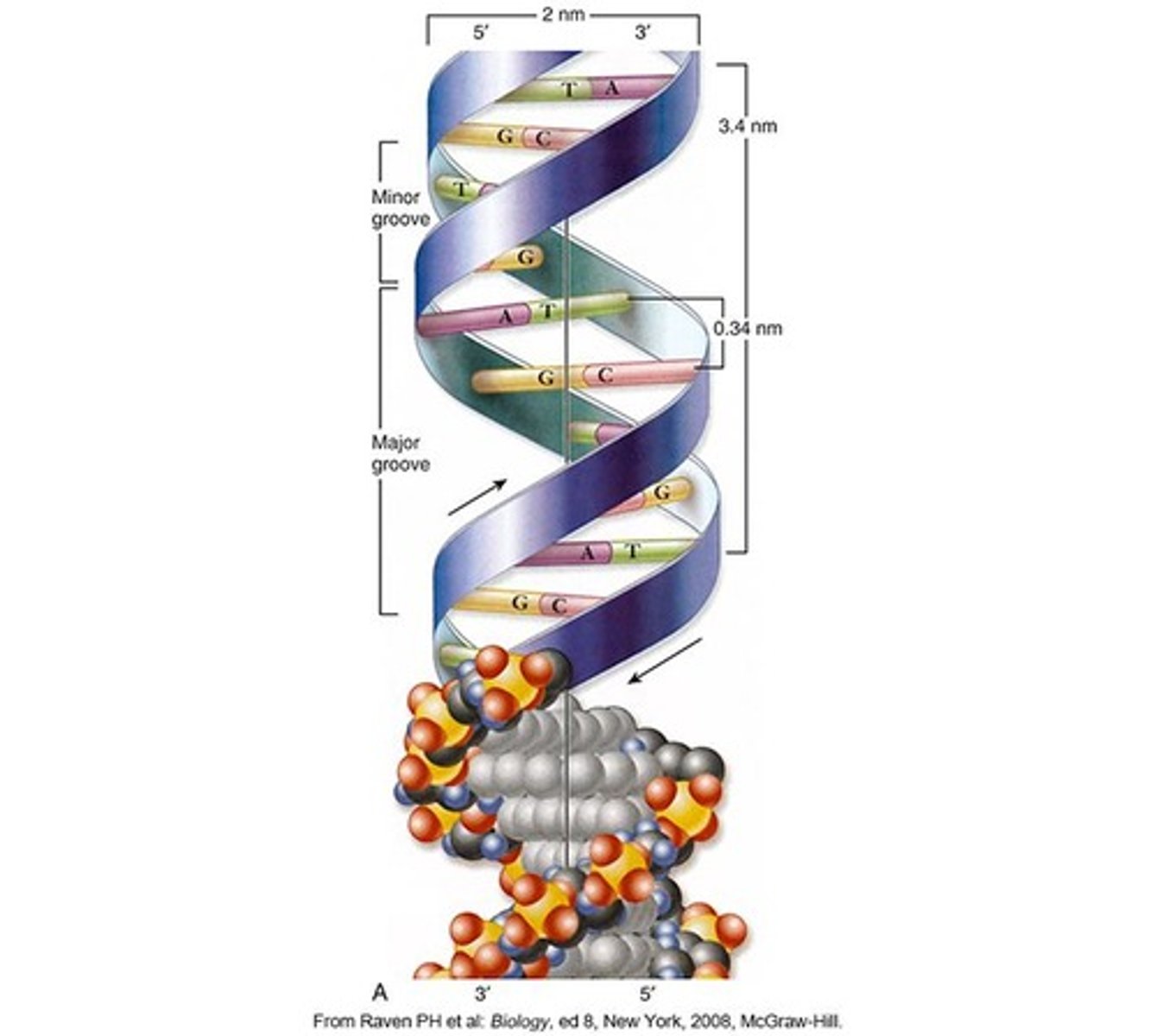
What are the components of a nucleotide?
One pentose sugar (deoxyribose), one phosphate group, and one nitrogenous base.
What are the purines found in DNA?
Adenine (A) and guanine (G).
What are the pyrimidines found in DNA?
Cytosine (C) and thymine (T).
What does DNA provide the code for?
All body proteins.
What are proteins composed of?
One or more polypeptides made of amino acids.
What directs the production of amino acids?
The sequence of three bases (codons).
What is a termination codon?
A codon that stops the production of protein.
What occurs during DNA replication?
The DNA strand is untwisted and unzipped, and DNA polymerase pairs complementary bases.
What is a mutation?
An inherited alteration of genetic material.
What is a base pair substitution?
A mutation where one base pair is substituted for another, potentially altering the amino acid sequence.
What is a frameshift mutation?
A mutation involving the insertion or deletion of one or more base pairs in the DNA molecule.
What are mutagens?
Agents such as radiation and chemicals that increase the frequency of mutations.
What is the role of mRNA in protein synthesis?
mRNA is synthesized from a DNA template and transports the genetic code to the cytoplasm.
What is transcription?
The process of synthesizing RNA from a DNA template via RNA polymerase.
What is translation?
The process by which RNA directs the synthesis of a polypeptide with the help of tRNA.
What is the role of the ribosome in protein synthesis?
The ribosome is the site of protein synthesis, helping mRNA and tRNA form polypeptides.
Where does protein synthesis occur?
Protein synthesis occurs at the ribosome.
What are the two types of human cells?
Somatic cells and gametes.
How many chromosomes do somatic cells contain?
Somatic cells contain 46 chromosomes (23 pairs).
What type of cells are gametes and how many chromosomes do they contain?
Gametes are sperm and egg cells that contain 23 chromosomes.
What is meiosis?
Meiosis is the formation of haploid cells from diploid cells.
What are autosomes?
Autosomes are the first 22 of the 23 pairs of chromosomes in males and females.
What are sex chromosomes in females and males?
In females, sex chromosomes are a homologous pair (XX); in males, they are a nonhomologous pair (XY).
What is a karyotype?
A karyotype is an ordered display of chromosomes based on length and centromere location.
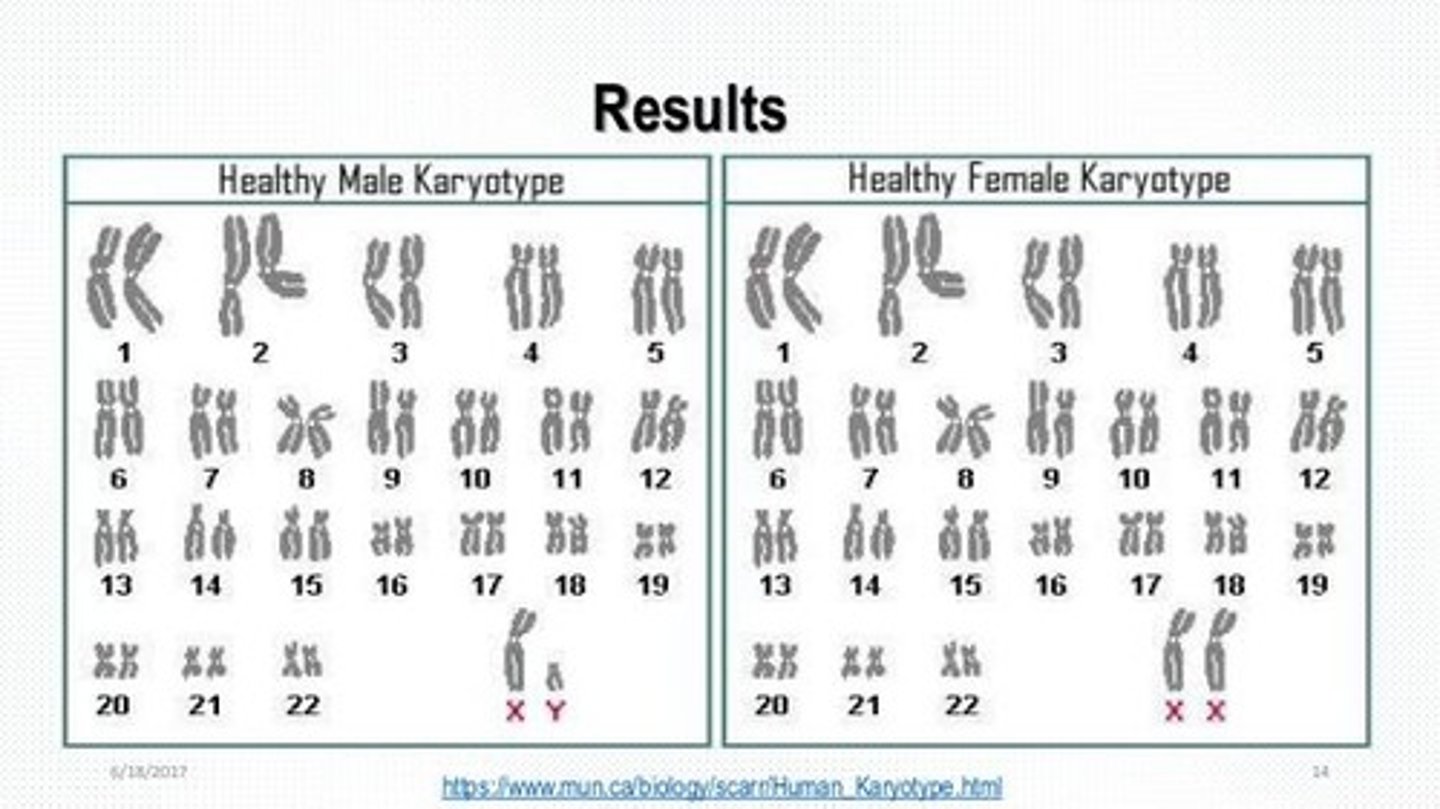
What are chromosomal aberrations?
Chromosomal aberrations are chromosome abnormalities that can lead to mental retardation and miscarriage.
What are euploid cells?
Euploid cells have a multiple of the normal number of chromosomes.
What is triploidy?
Triploidy is a zygote that has three copies of each chromosome (69 total).
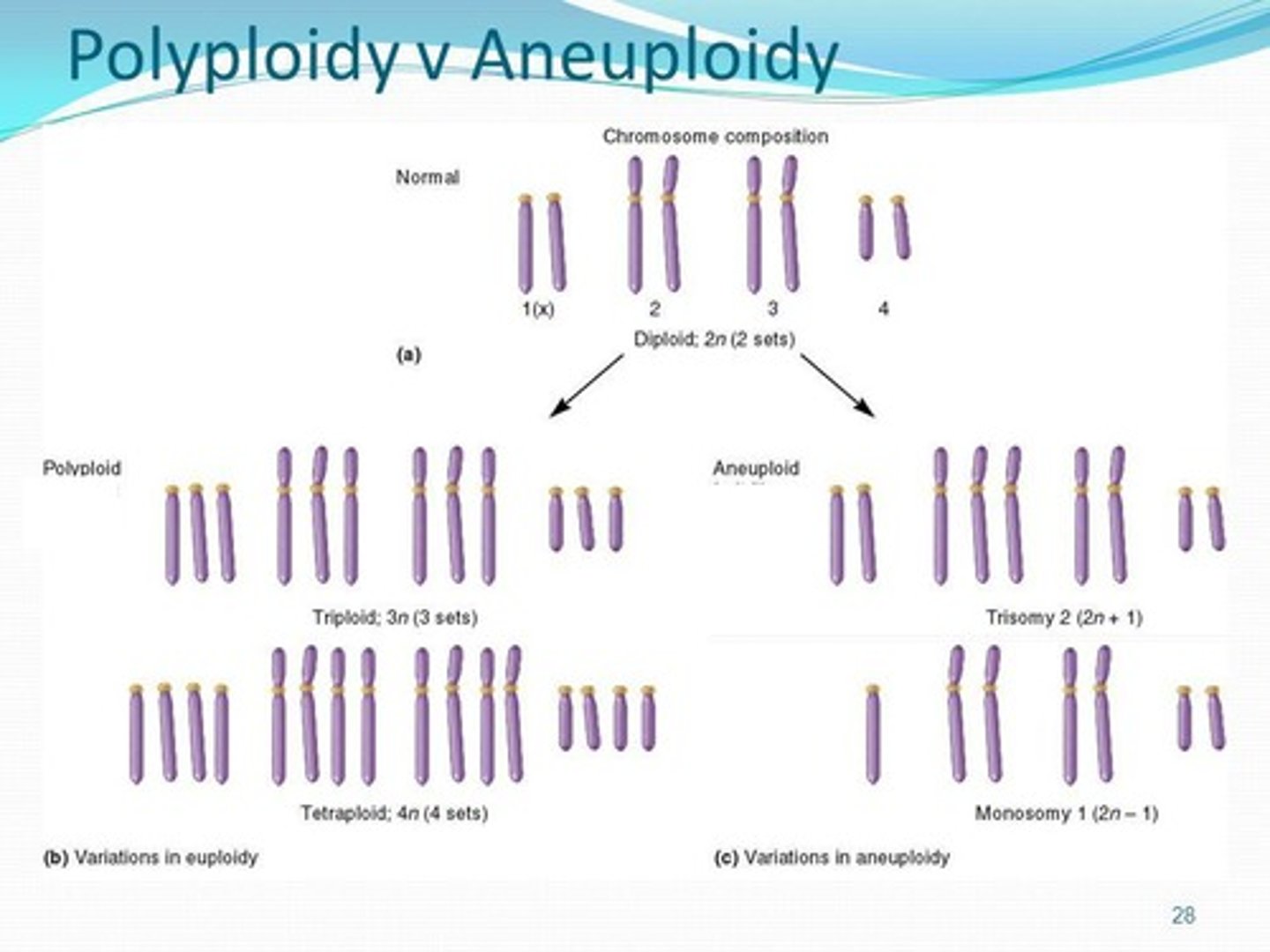
What is tetraploidy?
Tetraploidy has four copies of each chromosome (92 total).
What is aneuploidy?
Aneuploidy is a somatic cell that does not contain a multiple of 23 chromosomes.
What is trisomy?
Trisomy is a condition where a cell contains three copies of one chromosome.
What is monosomy?
Monosomy is the presence of only one copy of any chromosome, often fatal.
What are the consequences of aneuploidy of sex chromosomes?
Aneuploidy of sex chromosomes usually presents less serious consequences than autosomes.
What is Down syndrome?
Down syndrome is a form of aneuploidy characterized by three copies of chromosome 21 (trisomy 21).
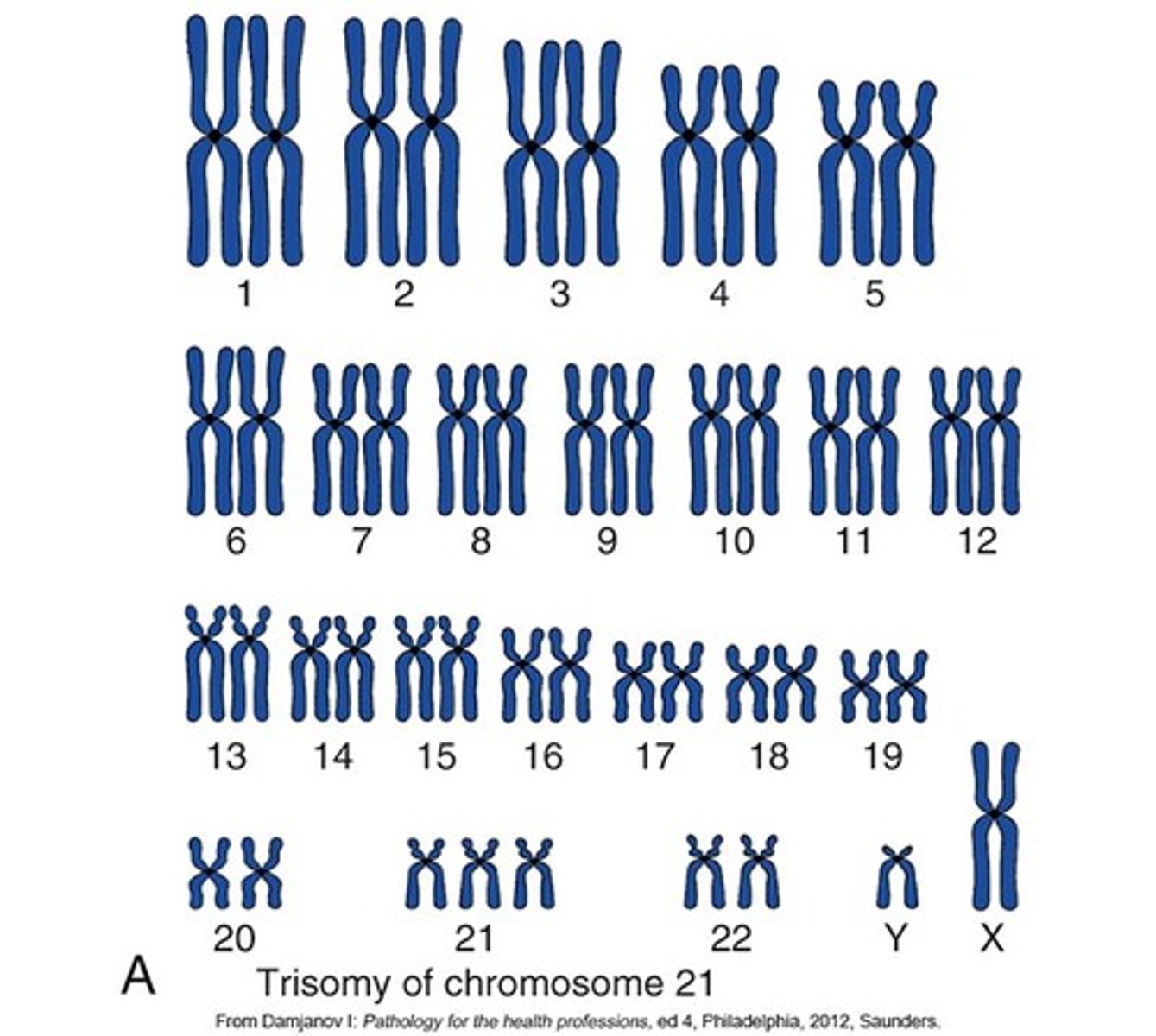
What are some manifestations of Down syndrome?
Manifestations include mental challenges, low nasal bridge, epicanthal folds, protruding tongue, flat low-set ears, short stature, and poor muscle tone.
What is the incidence of Down syndrome?
Down syndrome occurs in 1 in 800 live births.
What is Trisomy X?
Trisomy X is a condition where females have three X chromosomes, occurring in 1 in 1000 female births.
What are some symptoms of Trisomy X?
Symptoms can include sterility, menstrual irregularity, and cognitive deficits.
What increases the risk of Down syndrome?
The risk of Down syndrome increases with maternal age.
What are chromosomal mosaics?
Chromosomal mosaics are trisomies that occur in only some cells of the body, leading to different karyotypes.
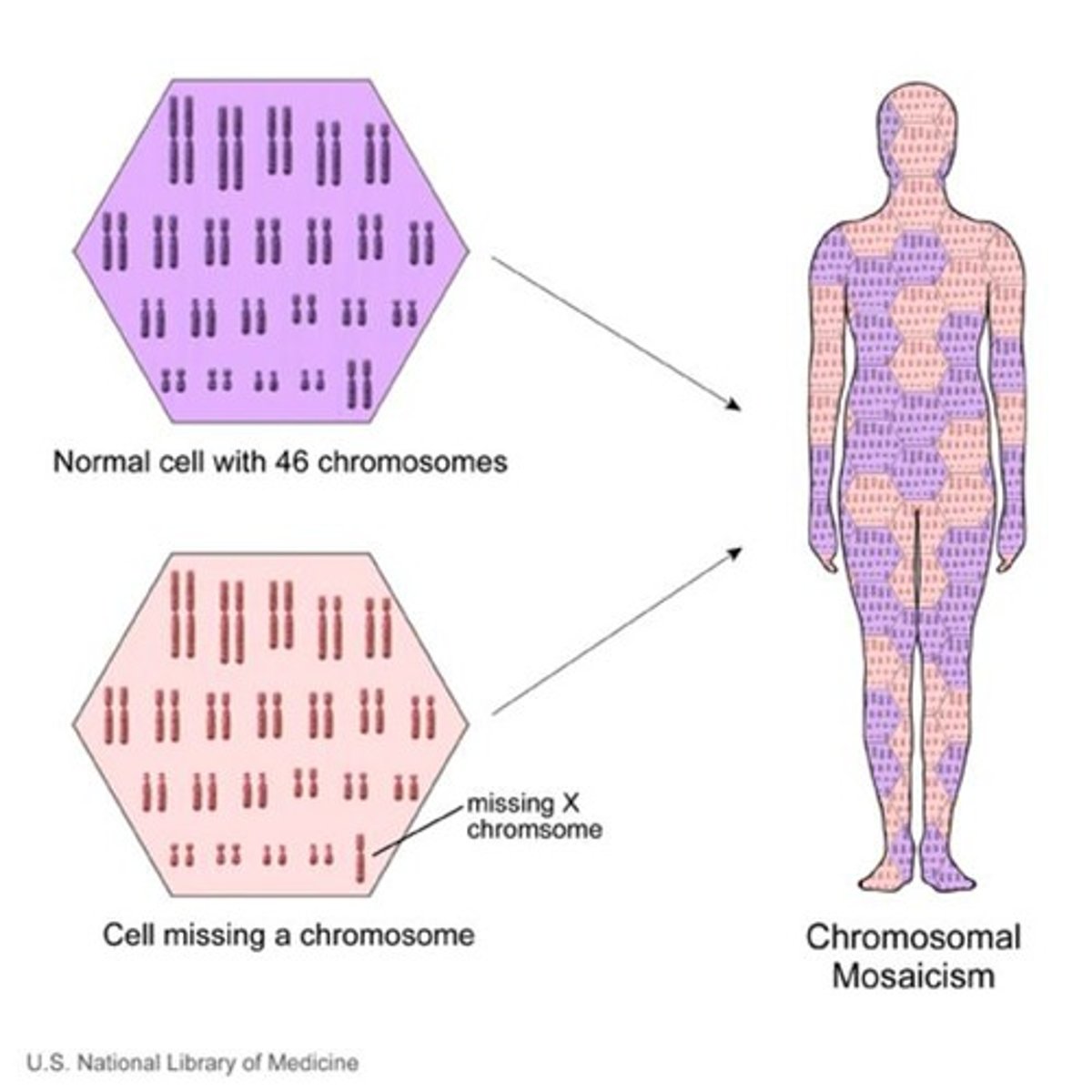
What are the symptoms of sex chromosome aneuploidy?
Symptoms are variable and include sterility, menstrual irregularity, and/or cognitive deficits, worsening with each additional X chromosome.
What is Turner syndrome and its karyotype?
Turner syndrome is a condition where females have only one X chromosome, denoted as karyotype 45,X. Characteristics include absence of ovaries, short stature, webbing of the neck, widely spaced nipples, and a high number of aborted fetuses.
What is the occurrence rate of Turner syndrome in female births?
Turner syndrome occurs in approximately 1 in 2500 female births.
What treatment do teenagers with Turner syndrome receive?
Teenagers with Turner syndrome receive estrogen.
What defines Klinefelter syndrome?
Klinefelter syndrome is characterized by individuals with at least one Y and two X chromosomes, leading to male appearance, female-like breasts (gynecomastia), small testes, and sparse body hair.
What is the occurrence rate of Klinefelter syndrome in male births?
Klinefelter syndrome occurs in approximately 1 in 1000 male births.
How does the number of X chromosomes affect Klinefelter syndrome?
Individuals can be XXXY or XXXXY, maintaining a male appearance, but abnormalities increase with each additional X chromosome.
What is the impact of maternal age on Klinefelter syndrome?
The disorder's occurrence increases with the mother's age.
What is Cri du chat syndrome?
Cri du chat syndrome is caused by a deletion on chromosome 5, characterized by low birth weight, mental challenges, and microcephaly.
What are the four major types of genetic diseases?
The four major types of genetic diseases are autosomal dominant, autosomal recessive, X-linked dominant, and X-linked recessive.
What is the recurrence risk in autosomal dominant inheritance?
The recurrence risk is the probability that a family member will have a genetic disease; if one parent is affected, the risk for each child is one half.
What is consanguinity?
Consanguinity, or inbreeding, is the mating of two related individuals, increasing the recurrence risk of recessive disorders.
How does consanguinity affect genetic disease recurrence risk?
Offspring of marriages between first cousins affected by genetic diseases have approximately double the recurrence risk compared to the general population.
What is X-linked inheritance?
X-linked inheritance involves disorders related to the X and Y chromosomes, with males being more affected due to having only one X chromosome.
What is the consequence of males inheriting an X recessive gene?
Males are always hemizygous; if they inherit an X recessive gene, they will express the disease because there is no normal allele to counteract it.
What is a characteristic of X-linked recessive inheritance?
The gene can be transmitted through female carriers, causing the appearance of a skipped generation.
How is an affected father related to X-linked inheritance?
An affected father passes the gene to all of his daughters, who become phenotypically normal carriers, transmitting it to approximately half of their sons.
What is the significance of X-linked recessive conditions in males?
Males are affected more often with X recessive conditions due to their single X chromosome.
What is the effect of duplications in chromosomal structure?
Duplications result in excess genetic material, usually having less serious consequences compared to deletions.
What is an inversion in chromosomal structure?
Inversion is a chromosomal rearrangement where a segment is inverted, such as ABCDEFG becoming ABEDCFG.
What is the impact of chromosomal abnormalities on offspring?
Chromosomal abnormalities, such as inversions, usually affect offspring.